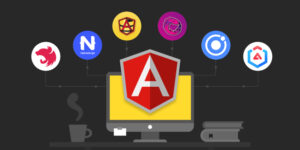
jQuery and Angular are two popular JavaScript libraries that have been used extensively for web development. While jQuery is a lightweight library that simplifies DOM manipulation and event handling, Angular is a comprehensive framework that offers features such as two-way data binding, dependency injection, and directives.
In this article, we will compare the features and performance of jQuery and Angular to help you understand the differences between the two.
Key Differences Between jQuery and Angular
jQuery is a JavaScript library that simplifies HTML document traversal and manipulation, event handling, and animation. It is primarily used for DOM manipulation and has a syntax that is easy to learn and use. Angular, on the other hand, is a full-featured framework for building web applications. It provides a complete solution for front-end development, including data binding, dependency injection, and routing. One of the main differences between the two is that jQuery is focused on manipulating the DOM, while Angular is focused on building web applications.
Performance Comparison
jQuery vs Angular
When it comes to performance, Angular is generally considered to be slower than jQuery. This is because Angular has a lot of overhead due to its complex architecture and features. However, Angular provides a lot of benefits that jQuery does not, such as two-way data binding and dependency injection. Ultimately, the choice between the two will depend on the specific needs of your project.
Benefits of Using Angular Over jQuery
One of the main benefits of using Angular over jQuery is that it provides a complete solution for front-end development. This means that you don’t need to use multiple libraries or plugins to achieve the same functionality. Additionally, Angular provides features such as two-way data binding and dependency injection, which can greatly simplify your code and make it easier to maintain.
1. Using jQuery in Conjunction with Angular
It is possible to use jQuery in conjunction with Angular, but it is generally not recommended. This is because Angular provides many of the same features as jQuery, and using both can lead to conflicts and performance issues. However, there may be certain cases where using jQuery can be beneficial, such as when working with legacy code or third-party plugins.
2. Data Binding in jQuery vs Angular
Angular provides two-way data binding, which means that changes to the model are automatically reflected in the view, and vice versa. jQuery does not provide this feature, and data binding must be done manually. This can make it more difficult to maintain and update your code.
3. Common Use Cases for jQuery
jQuery is commonly used for DOM manipulation, event handling, and animation. It is also often used in conjunction with other libraries or plugins to provide additional functionality.
4. Routing in Angular vs jQuery
Angular provides built-in routing functionality, which makes it easy to create single-page applications. jQuery does not provide this feature, and routing must be done manually or with the help of a third-party library.
Also See: React.JS vs Angular.JS The Better Option for IoT Product Development
Limitations of Using jQuery
One of the main limitations of using jQuery is that it is primarily focused on DOM manipulation and does not provide a complete solution for front-end development. Additionally, jQuery can be slower than other libraries or frameworks due to its large size and complex syntax.
Forms in jQuery vs Angular
Angular provides built-in form validation and data binding, which makes it easy to create forms that are easy to use and maintain. jQuery does not provide this feature, and form validation and data binding must be done manually.
Key Features of jQuery
Some of the key features of jQuery include DOM manipulation, event handling, animation, and AJAX requests. It is also known for its simple syntax and ease of use.
Key Features of Angular
Some of the key features of Angular include typescript, two-way data binding, dependency injection, routing, and form validation. It is also known for its modular architecture and ease of use.
Animations in Angular vs jQuery
Angular provides built-in animation functionality, which makes it easy to create complex animations and transitions. jQuery also provides animation functionality, but it is generally considered to be less powerful and flexible than Angular’s.
AJAX Requests in jQuery vs Angular
Both jQuery and Angular provide functionality for making AJAX requests, but Angular’s implementation is generally considered to be more powerful and flexible.
Best Practices for Using jQuery and Angular Together
When using jQuery and Angular together, it is important to avoid conflicts and performance issues. This can be done by using Angular’s built-in functionality whenever possible and minimizing the use of jQuery.
Dependency Injection in jQuery vs Angular
Dependency injection is a key feature of Angular that allows components to be easily reused and tested. jQuery does not provide this feature, and dependency management must be done manually.
Conclusion
In conclusion, jQuery and Angular are both popular tools for front-end development, but they have significant differences in their features and performance. While jQuery is primarily focused on DOM manipulation, Angular offers a complete solution for building web applications with features such as two-way data binding, dependency injection, and routing. Ultimately, the choice between the two will depend on the specific needs of your project and whether you prioritize ease of use or comprehensive functionality.






